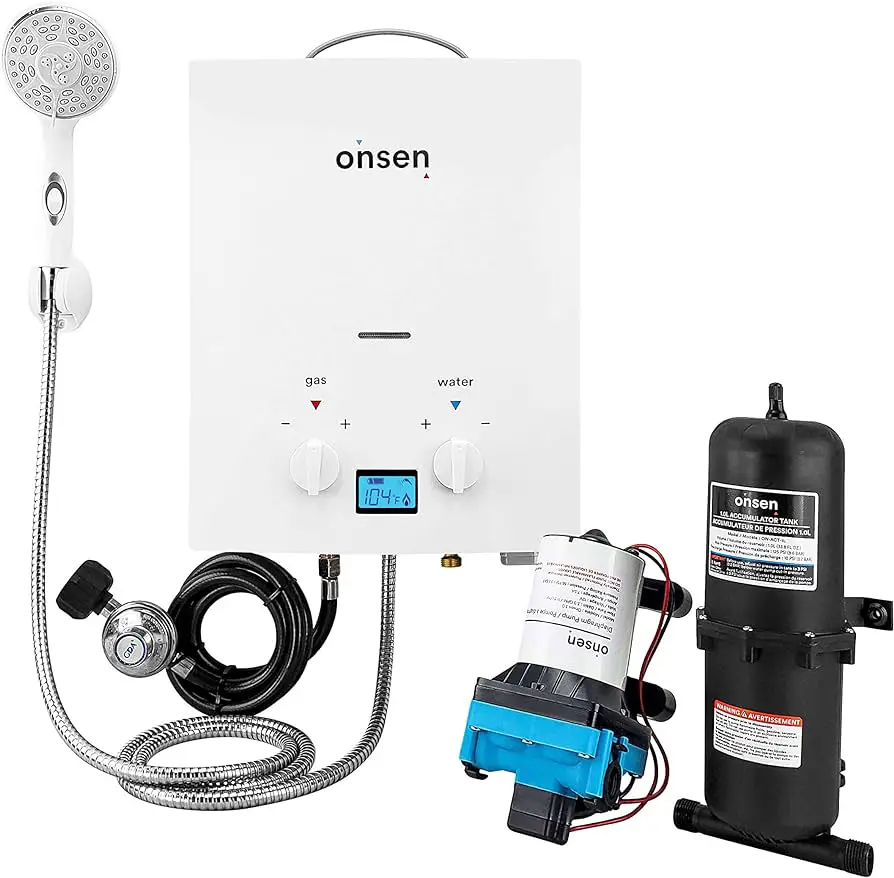An expansion tank for a tankless water heater helps to prevent pressure buildup in the system, extending its lifespan and improving performance. It absorbs excess water pressure to protect the unit and maintain optimal water pressure throughout the system.
A tankless water heater is a great way to provide hot water on demand, but without the right support, it can face issues. One essential component that helps ensure the smooth operation of a tankless water heater is an expansion tank.
This often-overlooked accessory can make a significant impact on the performance and longevity of the water heater. We will explore the importance of expansion tanks for tankless water heaters, their function, benefits, and why they are an essential addition to your tankless water heating system.
Understanding The Importance
The expansion tank plays a crucial role in the functioning of tankless water heaters. Understanding its importance is essential for homeowners and professionals alike to ensure the efficient and safe operation of these systems.
Definition And Function Of An Expansion Tank
An expansion tank is an essential component of the plumbing system, specifically designed to accommodate the expansion of water as it heats up within the water heater. It consists of a sealed container with a diaphragm or bladder that separates the water from a pressurized air cushion. As the water volume increases due to heating, the expansion tank allows the water to expand without causing a drastic increase in pressure within the water heater and the overall plumbing system. This prevents potential damage and prolongs the lifespan of the tankless water heater.
How Expansion Tank Benefits Tankless Water Heaters
When it comes to tankless water heaters, the inclusion of an expansion tank brings forth numerous benefits. Here’s how it benefits these systems:
- Prevention of Pressure Build-Up: By absorbing the expanded water volume, the expansion tank helps maintain a stable and safe pressure level within the tankless water heater, reducing the risk of leaks or damage.
- Prolonged Equipment Lifespan: The use of an expansion tank can extend the lifespan of the tankless water heater by reducing the strain on internal components and preventing unnecessary wear and tear caused by pressure fluctuations.
- Improved System Efficiency: By ensuring consistent pressure levels and reducing stress on the system, the expansion tank contributes to the overall efficiency of the tankless water heater, leading to energy savings and lower operational costs over time.
- Protection Against Water Hammer: The presence of an expansion tank helps minimize the occurrence of water hammer, which is the sudden increase in pressure caused by rapid water flow, thereby safeguarding the plumbing system and appliances connected to the water heater.
Selecting The Right Expansion Tank
When it comes to installing a tankless water heater, one crucial component that often gets overlooked is the expansion tank. Selecting the right expansion tank for a tankless water heater is essential to ensure optimal performance and longevity of the system. This crucial component helps regulate the pressure within the system, preventing the risk of damage to the water heater and maintaining consistent water flow. Let’s delve into the key considerations when choosing an expansion tank for a tankless water heater.
Sizing An Expansion Tank For A Tankless Water Heater
When it comes to sizing an expansion tank for a tankless water heater, it’s important to consider the water heater’s flow rate and the maximum temperature rise it provides. The expansion tank should be sized to accommodate the thermal expansion of the water within the system as it heats up. While some manufacturers provide specific guidelines for sizing expansion tanks based on the water heater’s specifications, a general rule of thumb is to select a tank with a volume approximately 10% of the water heater’s flow rate rating.
Factors To Consider When Choosing An Expansion Tank
- Water Heater Specifications: Consider the flow rate and maximum temperature rise of the tankless water heater to determine the appropriate size of the expansion tank.
- Material and Construction: Opt for an expansion tank constructed from durable materials such as stainless steel or high-quality bladder to ensure longevity and resistance to corrosion.
- Pressure Rating: Ensure the expansion tank’s pressure rating is suitable for the water heater system’s operating pressure to prevent any potential damage or malfunctions.
- Space and Installation Requirements: Take into account the available space for installation and select a tank that fits the designated area without obstructing other components of the water heating system.
- Regulatory Compliance: Verify that the expansion tank meets all relevant industry standards and regulations to guarantee safety and performance.
Installation And Maintenance Tips
In this section, we will cover important installation and maintenance tips for expansion tanks used with tankless water heaters. Proper installation and regular maintenance are crucial to ensure the optimal performance and longevity of both the expansion tank and the tankless water heater system. By following these guidelines, homeowners and professionals can effectively mitigate potential issues and prolong the lifespan of their tankless water heating systems.
Proper Installation Of An Expansion Tank
When installing an expansion tank for a tankless water heater, it is essential to follow the manufacturer’s guidelines and local building codes. Here are some key steps to ensure proper installation:
- Choose the right size expansion tank that matches the specifications of the tankless water heater system.
- Install the expansion tank in a vertical position with adequate support to ensure stability.
- Connect the expansion tank to the cold-water supply line before the tankless water heater to allow for proper expansion and contraction of water within the system.
- Ensure the system is properly pressurized and that all connections are leak-free.
- Regularly inspect the expansion tank for any signs of damage or corrosion and address any issues promptly.
Regular Maintenance And Troubleshooting For Optimal Performance
To maintain optimal performance of the expansion tank and the tankless water heater system, regular maintenance is essential. Here are some key maintenance and troubleshooting tips:
- Periodically check the pressure in the expansion tank to ensure it is within the recommended range. Adjust if necessary.
- Inspect the expansion tank for waterlogged or failed bladder issues, which may require replacement.
- Clean the expansion tank and surrounding area to prevent accumulation of debris or sediment.
- Monitor the overall performance of the tankless water heater system and address any anomalies promptly.
- Regularly flush out the tankless water heater to remove mineral buildup and sediment that can affect its performance.
By following these installation and maintenance tips, homeowners and professionals can ensure that their tankless water heater systems operate efficiently and provide reliable hot water for years to come.

Credit: www.cafeappliances.com
Integration With Tankless Water Heater System
Tankless water heaters are renowned for their energy efficiency and consistent hot water supply. However, the integration of an expansion tank is essential to maximize the functionality and lifespan of a tankless water heater system.
Ensuring Seamless Integration With The Tankless Water Heater
Integrating an expansion tank with a tankless water heater system is crucial for ensuring optimal performance. The expansion tank works in conjunction with the tankless water heater to accommodate the fluctuations in water pressure that occur during the heating process. By seamlessly integrating the expansion tank, the overall efficiency and reliability of the tankless water heater system are significantly enhanced.
Optimizing The System Efficiency With An Expansion Tank
Optimizing the system efficiency of a tankless water heater is paramount for ensuring consistent hot water supply and reducing the strain on the system components. An expansion tank plays a pivotal role in achieving this optimization by absorbing the excess pressure and stabilizing the water flow within the system. This not only prolongs the lifespan of the tankless water heater but also contributes to energy savings and reduced maintenance requirements.
End of the blog post section “`Frequently Asked Questions For Expansion Tank For Tankless Water Heater
Are Expansion Tanks Required For Tankless Water Heater?
Expansion tanks are recommended for tankless water heaters to prevent pressure build-up. They help manage thermal expansion, extending the unit’s lifespan and reducing maintenance needs.
Where To Install Thermal Expansion Tank On Tankless Water Heater?
The thermal expansion tank for a tankless water heater should be installed on the cold water supply line. It should be placed close to the water heater to regulate pressure. This helps prevent damage to the heater and plumbing system.
Regular maintenance is also important.
Do I Really Need An Expansion Tank On My Hot Water Heater?
Yes, an expansion tank is essential for a hot water heater to prevent pressure build-up and ensure its proper functioning.
Does A Navien Tankless Water Heater Need An Expansion Tank?
Yes, a Navien tankless water heater requires an expansion tank to manage thermal expansion.
Conclusion
Adding an expansion tank to your tankless water heater can prevent pressure fluctuations and prolong the lifespan of your unit. As an essential component, it enhances performance and reduces maintenance costs. With this simple addition, you can ensure a consistent and efficient supply of hot water throughout your home.

